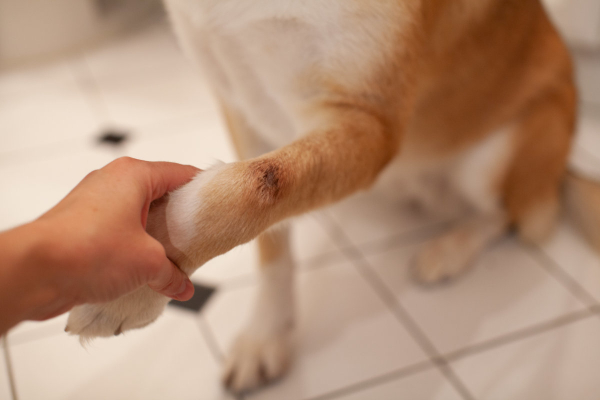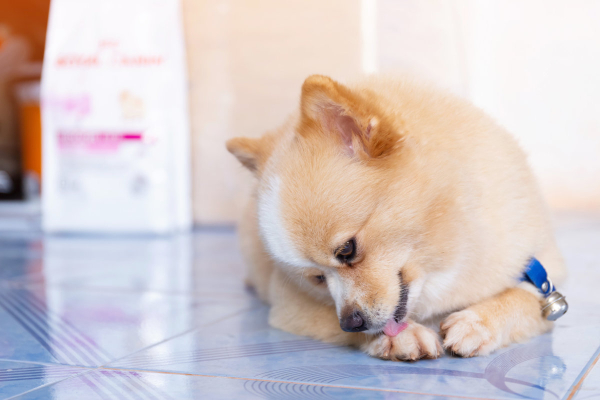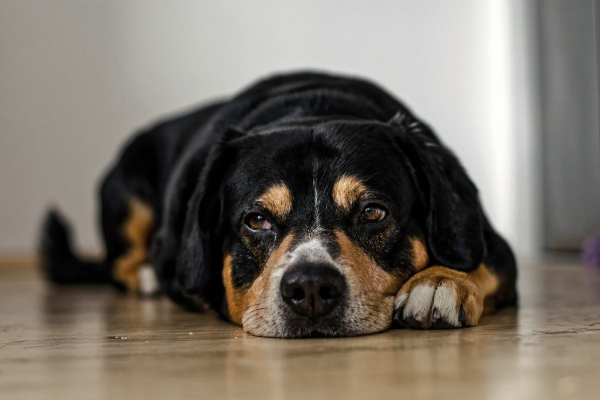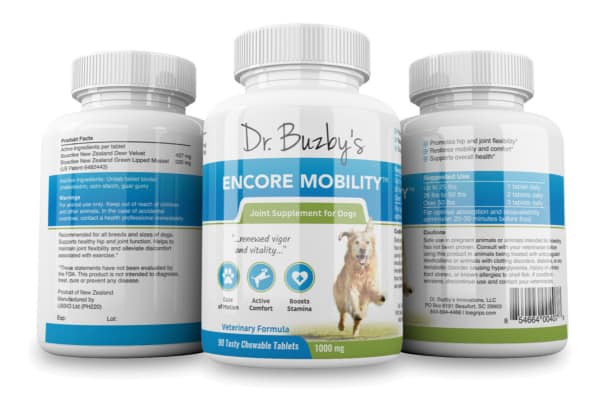When dealing with a lick granuloma, dog parents may find themselves a bit discouraged. Integrative veterinarian Dr. Julie Buzby explains why getting the spot to heal can take some time, and treatment may involve some trial and error. Find out what lick granulomas are, why they happen, and what you and your vet can do to help your dog.

It’s not uncommon for dogs to lick themselves. Perhaps they are soothing an area of minor irritation like a bug bite. Or maybe they are trying to get every last bit of leftover flavoring off their fur after chomping on a tasty chew they were “holding” with their paws. Whatever the reason, licking does happen sometimes.
However, frequent licking is concerning. Especially if it is concentrated on one area, excessive licking can cause problems for your dog. Acral lick granulomas are one issue that can arise if your pup persistently licks a particular spot.
What is a lick granuloma in dogs?
A lick granuloma, also known as acral lick dermatitis, is a skin condition that can occur when dogs self-traumatize an area by licking too much. The term “acral” refers to the extremities. Because lick granulomas occur only in places a dog can reach to lick, the most common affected area is the top of the front legs, usually near the carpus (wrist) or paw.
What does a lick granuloma look like?
In the early phases of a lick granuloma, you may notice a well-defined wet spot with some redness (i.e. erythema) and hair loss (i.e. alopecia) on your dog’s front leg. This general appearance also goes with a type of skin infection known as moist dermatitis—sometimes called a hot spot. However, as a result of the excessive licking, lick granulomas extend deeper into the skin than mild superficial skin infections.
As time goes on, lick granulomas can appear deeply red or even eroded and ulcerated. Often, they can have distinct borders and an oval or round shape. Over the course of a few weeks, a lick granuloma can become thickened as the body lays down scar tissue in an attempt to heal the abnormal area. Thick crusts and plaques can also form over or around the granuloma.

What causes a lick granuloma in dogs?
The causes of lick granulomas can usually be generalized into two categories: allergies and behavioral conditions. We often never find out the specific inciting incident that starts the formation of the granuloma. Dogs may begin to excessively lick a certain area for a variety of reasons, and if there is visible irritation we may not see it under the fur.
Dogs who develop lick granulomas may even suffer from a combination of BOTH allergies and behavioral issues!
Allergies
Skin allergies can be triggered by any number of factors including:
- External parasites (fleas, ticks, etc.)
- Environmental allergens like dust and pollen
- Certain foods
Exposure to allergens can cause intense skin inflammation and itchiness. Unfortunately, this can lead to an “itch-lick cycle.” The dog licks an itchy spot, which causes some mild moist dermatitis. That dermatitis is itchy, so the dog licks it. Rinse and repeat.
For some dogs, licking an itchy area can also trigger an endorphin release. This helps the dog relax and may alleviate some discomfort coming from the areas of damaged or inflamed skin.
Behavioral concerns
The fact that licking releases soothing endorphins may also contribute to lick granulomas in dogs with behavioral issues. Dogs who suffer from separation anxiety are stressed when their family is away, so licking may help them calm down.
In the same way, repetitive licking as part of obsessive compulsive disorder (i.e. canine compulsive disorder) can lead to acral lick granulomas. A dog may constantly lick a spot as a soothing habitual action.

Additional causes
Besides allergies and behavior problems, lick granulomas may also result from:
- Pain or abnormal sensations associated with osteoarthritis in dogs
- Focal skin infections
- Bites or other wounds
- Foreign bodies like thorns stuck in the skin
- Localized skin cancers or benign tumors
Which dogs tend to get lick granulomas?
As you can gather from the list of causes, there is going to be an overlap between the dogs who are prone to allergies and/or behavioral problems and those who develop lick granulomas. And while any age, size, and gender of dog can develop lick granulomas, they tend to be more common in large breed dogs.
Predisposed breeds include:
- Boxers
- Doberman Pinschers
- German Shepherds
- Golden Retrievers
- Great Danes
- Irish Setters
- Labrador Retrievers
- Weimaraners
Regardless of whether or not your dog has one of these predisposing factors, if you suspect that your dog has a lick granuloma or other skin problem, make an appointment with your vet. The sooner you get a diagnosis, the sooner you can start treatment for the lick granuloma.

How will the vet diagnose a lick granuloma?
At the appointment, your vet will probably start out by carefully evaluating the suspect area on the skin. Many times, the vet will presumptively diagnose your dog with an acral lick granuloma. He or she will base the diagnosis on the classic appearance of the spot on the skin and history of seeing the dog excessively licking the area.
However, despite having the textbook appearance of a lick granuloma, occasionally the spot can actually be something else, such as a mast cell tumor in dogs. Your vet may recommend diagnostic testing to make sure the presumed lick granuloma isn’t something more sinister.
Fine needle aspirate
One such test is a fine needle aspirate (FNA). During an FNA, the vet uses a small needle to collect some cells from under the skin. Then he or she will examine the cells using a microscope. These cells can often tell us whether the spot is cancerous or benign.
Biopsy
For cases where a fine needle aspirate does not give a conclusive answer, or looks suspicious for a cancerous mass, skin biopsies can give more information on what the spot may be. Often performed under general anesthesia, a skin biopsy involves cutting a small portion of the area out and sending it to a laboratory for testing.
Biopsy results are generally more specific and reliable than those from FNAs, but it is a more invasive procedure.
Cytology
Your vet may also want to do a skin cytology or skin impression test. A study published in the journal of Veterinary Dermatology indicated that 97% of lick granulomas have a secondary bacterial infection. Cytology is similar to a fine needle aspirate, but only evaluates the most superficial cells, rather than cells inside the lesion or underneath the skin.
For a skin cytology, the vet will scrape some material off the surface of the skin lesion and apply it to a microscope slide. For a skin impression test, the vet presses a glass slide against the abnormal area on the skin. Alternatively, sometimes clear tape can be pressed to the lesion to pick up cells, then placed onto a slide. The vet will then evaluate the material on the slide for signs of infection or abnormal cells.
Sometimes the vet will suggest additional testing. This may involve:
- Skin scrape to look for demodex mites or other irritants
- Fungal culture to check for ringworm
- Bacterial culture to determine which bacteria are present and guide antibiotic selection
What is the treatment for a lick granuloma?
Once your vet diagnoses your dog with a lick granuloma, he or she will discuss treatment options. Unfortunately, there is no one-size-fits-all treatment for lick granulomas. So this may mean it will take some trial and error to find the right combination of treatments. Keep in mind that you must not only treat the acral lick granuloma itself, but also the underlying conditions that led to it.

Antibiotics
Since we know almost all lick granulomas have a bacterial infection, most require antimicrobial therapy for treatment.
Constant licking breaks down the surface of the dog’s skin, allowing bacteria that would normally populate the surface of the skin to migrate deeper in the skin and cause an infection. Also, mouth bacteria can enter the area of broken skin from the licking. Because these are often deep infections, oral antibiotics may be prescribed for up to eight weeks or more.
Topical products
In addition to oral antibiotics, topical medications that contain antibiotics can also be extremely useful. In some cases, they may reduce the need for systemic antibiotics.
Some veterinarians will even use topical ear medications like Claro or Synotic to treat lick granulomas. These products contain combinations of antibiotic, antifungal, and anti-inflammatory ingredients that can treat the infection while providing itch relief.
Anti-inflammatories
As you may imagine by their irritated, sometimes ulcerated appearance, lick granulomas are associated with significant inflammation. Thus, the vet might prescribe a course of anti-inflammatory medication to help to break the itch-lick cycle. Some popular options include NSAIDs like carprofen for dogs or steroids like prednisone for dogs.
These medications are helpful because they make the dog feel better and decrease further trauma to the area. However, it is important to keep in mind that typically you also need to address the underlying cause and treat the secondary infection to have the best chances of the lick granuloma resolving.
Important note: Steroids and NSAIDs should not be given together to dogs. The combination of these medications can have dangerous side effects.
Elizabethan Collars
I know. Nobody likes the “cone of shame.” But preventing a dog from licking is paramount to getting a lick granuloma to heal. I wish I could explain this to my patients, but it is extremely difficult to deter licking without a physical barrier.
Covering the area can sometimes help, but many dogs will chew or lick at the covering. Because lick granulomas are associated with moist dermatitis, leaving on a wet bandage only exacerbates the problem. Additionally, bandages and booties may be chewed off and consumed, potentially causing dangerous foreign bodies.
That is where the Elizabethan collar (i.e. E-collar) comes in. The E-collar creates a physical barrier between the dog’s mouth and paws, preventing licking. Keep in mind that soft E-collars are bendable, and usually don’t effectively limit the dog’s access to the affected area.
Additional treatment modalities
Dogs with acral lick dermatitis may also benefit from:
- Acupuncture for dogs—Placing acupuncture needles around the lick granuloma may lessen the itchiness.
- Laser therapy for dogs—Using a cold laser to apply a low-energy beam of light to the lick granuloma can help speed up healing.
- CO2 laser surgery—Typically, this option is reserved for chronic or non-healing granulomas. Removing scar tissue and dead skin cells from the lick granuloma exposes healthier layers of skin, which makes it easier for other treatment options to promote healing and provide relief.
Control of underlying causes
In addition to treating the actual lick granuloma, it is imperative that you address the underlying cause. If we do not manage the underlying issue, the lick granuloma is likely to recur.
Allergy treatments
There are a plethora of allergy medicines for dogs. Medications like Apoquel and Cytopoint can give itchy dogs some relief by blocking the itch signals the body releases in response to allergen exposure. This does not “cure” the allergy itself, but decreases the symptoms, making dogs scratch and lick less frequently.

Dogs with environmental allergies can also benefit from immunotherapy (i.e. allergy shots). Allergy testing determines the exact allergens the dog reacts to, and vet specialists can then produce immunotherapy injections based on those results. These injections should make the allergic reactions less intense over time.
However, allergy testing and immunotherapy are generally not useful for dogs with food allergies. Instead, most vets will recommend a food trial. This involves feeding a novel protein or hydrolyzed protein diet exclusively for 8 to 12 weeks. If the itching improves significantly, the dog can continue to eat that diet long term.
To pinpoint the exact allergen, you can always reintroduce one suspected allergen (e.g. chicken or beef) at a time. If the dog becomes itchy again, this confirms the dog is allergic to that ingredient. Avoiding that allergen in the future will help control food allergies.
Addressing anxiety
Since anxiety and other behavioral conditions can also cause lick granulomas, your veterinarian may discuss options to help your furry friend relax. Determining that anxiety is the underlying cause may involve ruling out allergies first, so this can take some time and may be frustrating.
Your vet may recommend using medications like fluoxetine or clomipramine to ease your dog’s anxiety. Each individual reacts differently to behavioral medications, and some may have to be given for several months in order to determine whether they will be effective. During that time, you can work on plans for behavior modification. This may include eliminating visual cues that set off your dog’s separation anxiety, mitigating responses to loud sounds like thunder, etc.
Additionally, sometimes focusing on canine environmental enrichment and increasing your dog’s activity can make a big difference. This could involve sending your dog off to doggy daycare for a few hours, going for a longer run or walk, or providing some food puzzle toys. Tiring out your dog’s body and mind can help them stay calm and relaxed.

Arthritis management
Since some dogs lick repetitively in response to pain or abnormal sensation from arthritis in dogs, finding ways to relieve arthritis pain in dogs can be helpful.
Additionally, joint supplements for dogs are a great idea. Dr. Buzby’s Encore Mobility™ hip and joint supplement has great anti-inflammatory effects which are perfect for dogs with lick granulomas and arthritis.
Save 10% on Encore Mobility™ Joint Supplement for Dogs

Give your dog more good days.
Use promo code HAPPY to save 10% on Encore Mobility.
At-home treatment for lick granulomas
In combination with these other treatments, you can try some techniques at home to keep your dog from licking an already established lick granuloma.
In addition to tools like E-collars, noxious topical products like Bitter Apple spray can also be effective because they taste awful. Generally, you would need to apply the yucky tasting substance in small amounts every eight to twelve hours to prevent licking.
Lick granuloma treatment takes time
Even if you do everything right, it is important to keep in mind that some acral lick granulomas can take several months to resolve. Lick granulomas are one of the more frustrating conditions that we treat in veterinary medicine. Most heal slowly, and it can take time to find the right treatment. Unfortunately, some never do fully resolve.
While you are treating your dog’s lick granuloma, periodic check-ins with your veterinarian are vital to the process. He or she may want to recheck the skin cytology to ensure that any skin infection at the granuloma site is responding to therapy. Also, if initial therapies aren’t helping, your vet can come up with a new plan or additional therapies.
Following your vet’s directions is critical. Even something as simple as leaving the E-collar off can set back resolution for weeks, or perhaps months. I know it isn’t fun to need to put an E-collar on your dog, give daily medication, or otherwise change the way you care for and interact with your dog for a period of time. However, if it means getting the lick granuloma to improve, it is worth it.

How can you prevent a lick granuloma?
Knowing how difficult it is to manage a lick granuloma once it is established, it only makes sense that trying to prevent one from starting would be ideal. If you know your dog has allergies, anxiety, or other factors that predispose him or her to lick granulomas, keep these prevention tips in mind:
- Administer prescribed medications as recommended by your vet.
- If your dog suffers from environmental allergies, work with your vet to create a bathing and grooming routine to help remove surface allergens.
- Consider naturally calming treatments and supplements such as Zylkene, Composure Pro, and Solliquin if your dog struggles with anxiety.
- Promptly report any changes to your dog’s level of itchiness, skin appearance, or pain or anxiety levels to your vet.
- Break out the E-collar or lick deterrents if you notice that your dog is starting to constantly lick an area. Then make a vet appointment to get to the root cause of the licking.
Work with your vet
The sooner you can start treatment and the more you stay in communication with your vet, the lower the chance the dog will end up with a chronic or difficult-to-treat acral lick granuloma. Hopefully, with a bit of patience and persistence, your dog will be able to recover quickly and “lick” his or her lick granuloma once and for all!
Has your dog had a lick granuloma?
Please comment below


Earlier this year I finally asked my neighbor (a farmer in his mid-sixties who lives alone) if I could take his huge, gorgeous Anatolian Shepherd (8 years old, named Gunner) to the vet for an exam. I have long been concerned that Gunner has not been receiving the care and attention he needs, both emotionally and medically. My chief concern was the wound on the front of his foreleg. It began as a cut from scooting under a barbed wire fence and became an acral LG according to the vet. The neighbor, who has had back surgery, was simply too overwhelmed with everything else going on in his life and allowed the wound to go untended for months. The vet gave Gunner a shot of depo behind the LG, a shot of Convenia, and prescribed Animax daily under a dressing of Telfa pad and vetwrap. I put hot sauce on it to keep Gunner from chewing and licking the bandage. He has in the past apparently destroyed two E-collars and he (sadly) is rarely allowed in the house. I have been going over to put on the Animax and rewrap the leg every day. The LG is definitely improving but I think he may be developing a tolerance to the hot sauce because he’s not as reluctant to lick and nibble the bandage as he used to be and is now developing a second smaller LG right above the bandage line! So I have ordered some Bitter Apple to see if that better discourages licking. I am committed to helping him, and thankfully the farmer is allowing it!
It has been one month now, and Gunner is going in for a second depo shot behind the LG on Friday. I did discover a leathery nickel-sized lump growth on the back point of his elbow on the same leg and I am concerned it’s a tumor. Mast cell maybe? Cancerous? Related at all to the LG? I don’t know yet. But I’m frustrated and concerned, particularly because I have a two-week trip coming up in April and I am unsure if the farmer will be fit enough to continue this level care. I am hopeful Gunner will be sufficiently improved by then so the care will be less involved. I am determined to do my best for him. He is wonderful, wonderful creature. Laid back, gentle, compliant, intelligent, so handsome…and hungry for lots more love than he gets, I think. I am gratified, however, that the farmer has really noticed how positively Gunner responds to me and has made good changes in the way he is caring for his dog at home (improvements to his bedding and doghouse, allowing him inside for longer stretches, brushing him every day, buying better quality food, etc.).
Dear Kristin,
Bless you! You are an angel, and I commend you for taking on the care for this deserving pup. I am not sure if you have access to laser therapy at any of the clinics in your area, but that could be extremely helpful in the healing process for the LG. The growth on the back of Gunner’s elbow may be a callus forming over the pressure point, but it still would be good to have it evaluated by your vet. Here is a link to another article with more information: Dog Elbow Callus: What’s Normal and What’s Not
You are doing a phenomenal job, and I am so happy your neighbor is staring to make improvements in the way he cares for Gunner. Feel free to keep us updated on how things go. Praying for continued success and wishing you both all the best. ♥
Kristen – I couldn’t read your Story both Sad and Sweet? without taking a quick moment to tell you what I Hope you already know. Gunner surely has been Blessed after 8 Very Long Years of Waiting, to Finally have His Angel here on Earth 🌎 come to Rescue him with Love and Care that He should have had All of of his Life. But I’m so Very Grateful to you for Seeing Gunner’s Needs and Selflessly Fullfilling them for him as Best as you’re able. I know that it must Break your Heart ❤️ that Gunner is still living Outside, it would mine too. Anatolian Shepherds are Strong Dogs and They Love the Outdoors so for the Most Part Gunner is Enjoying his Days☀️ & Nights🌙 under The Beautiful Skies especially if The Farmer is Outdoors too. Perhaps you could mention that to Gunner’s Owner. Now that Gunner is getting on in age that he would possibly much prefer to spend his Overnight Time no longer being Alone and would rather be with him. Often Acral LGs are caused by Stress and Anxiety that comes with Age in All of Us but especially to Older Dogs who are Alone. And when left Outdoors Alone at Night Noises that used to be Nothing at All to Them are Suddenly Extremely Frightening for Older Dogs (believe it or not) even for Deaf Dogs ! Vibrations become a New Sensation of Scary for Newly Deaf Elderly Dogs Alone.. The Night is Full of Frightening Noises for Anyone who is Alone Outside. Human or Animal. Young or Old. Hearing or Nearing Deafness. 8 Years is Very Much a Senior for a Shepherd and I Surely Believe that Gunner would love a Soft Place just Inside of The Door.
In the Meantime, Kristen, You have Guaranteed your Soft Place Inside of Heaven for Certain and Something tells me that this is not the 1st Time that you have Given of yourself so Very Willingly and Lovingly to One In Need. This World 🌎 NEEDS a Whole Lot More of People like you and though there are Some, The Animals NEED More Help. They Out There Everywhere. Next Door and A World Away Desperately In Need of Someone to See Their Acral LGs. and Hurt Paws or Hungry Bellys and Broken Bones and Shattered 💕 Hearts. War Torn Countries and Poverty and Cruelty Everywhere. There are Animals Suffering Waiting Hoping that there is Someone like YOU that will be coming for Them at Any Moment Now. Gunner waited and YOU Arrived One Day. Thank You Kristen. PLEASE Tell Others of Your Courage to Look Next Door or Across The Street. Or on your way to Work Each Day. Some Animal is Waiting There too for Someone to See Them. To Help Them. Your Story Should be in The News ! To Encourage Others to Do The Same. Blessings to You and Gunner and All Those Animals In Need Everywhere.
Hi Dr. Buzby – This is best written blog I’ve found on the web for this condition. We just rescued a intact juvenile Springer Spaniel last week who was crated far too long and suffers from lick granulomas on three paws. We saw our vet who prescribed Animax topical and an E Collar. He is on Trazadone and Gabapentin for anxiety. The anxiety meds calm him down to a point where we can at least work with him but have had a terrible time with the collar and topical meds.
I suspect his granulomas are due to sexual frustration and boredom although he is pretty anxious too. This last week we have worked on getting him into an acclimated routine of walks, training and gettiing more trusting of us with training, treats, and calmer (when we can) behaviors. I have a behavior therapist/trainer who is working with us , a much needed neuter, and plan to try a different e-collar solution that doesn’t stress us both out to get on / keep it on him.
He has been a real challenge to get and keep the collar on the boy has been a non-starter for us. I really want to get his feet sorted out but its like he is working against us. Do you have any additional advice for us beyond our current plan? Many thanks for your great work.
Pat
Hi Pat,
I am sorry your young guy has endured so much in his short life. He is very lucky to have found you and have you advocating for his health and well-being. It sounds like you are doing all the right things and have a good team in place working hard at finding a solution. I would encourage you to consider laser therapy. I have seen it do amazing things for patients with lick granulomas. Other than that, I am not sure I have any additional advice to offer. Wishing you both the best of luck and feel free to leave an update as things progress. Keep up the good work!
Hi,
My dog has carpal hyperextension. No surgery. He did great for several months.
The last few weeks he can only take a short walk before he starts to struggle and today i noticed a lick granuloma in between his toe. The toe on the carpal hyperextension foot.
Is this because he is in pain?
I would appreciate your opinion.
Thank you so much!
Mandy.
Hi Mandy,
Sorry to hear that your pup had carpal hyperextension and is starting to struggle with getting around. I could see that pain or abnormal sensation in the foot could potentially lead to increased licking and a lick granuloma. However, since you said it was between the toes, I also wanted to mention that dogs can develop interdigital cysts, which usually look like painful red bumps between the toes. I’ll link to an article about interdigital cysts so you can read more about them.
Either way, it would be a good idea to make an appointment with your vet to get his foot checked out and to see what can be done to help him get around better. I hope you are able to find some answers for him and he starts to feel better soon!
Here is the article I mentioned: Interdigital Cyst in Dogs: A Painful Bump Between Your Dog’s Toes
Thanks for the article. My poor shepard/lab mix has been struggling with one for about 3 months now. Its driving me up the wall because he gets anxious and stressed when i put the cone of shame on—but he won’t stop trying to lick the wound without it!! Even with anti lick tape, gauze, and socks on(at various times) he’ll chew through. It’s incredibly frustrating as I am trying to listen to my vet but the rest of my family will remove the cone at their convenience(he rams into us full speed and takes out knees haha).
Hi LC,
Those cones are such great tools but can be extremely frustrating. I understand your concern for your pup and this chronic licking problem he is dealing with. How are things today? Has the problem improved any or still no resolution? Don’t forget you can always ask for a consultation with a veterinary dermatologist if needed. They could have ideas about treatments or therapies that are not readily available in general practice. Your boy is lucky to have you advocating for his health and well-being. Praying for a positive outcome. Keep up the good work!
My 7 yo spayed Newf has had 2! Same spot: back left leg near front ankle. First one exactly 3 y ago and second just recently. Both excised surgically and tested positive for LG. At site of external stitches recently, I noticed a small (1/8″) area red (again). I am treating it with Nolvasan at the moment. Last week, she was dx’d with mild/severe arthritis in her left elbow and Dr. (neuro/ortho vet) is treating her with Meloxicam and Amantidine (he saw her for front end lameness and had no history of her with her LG). Interestingly, she doesn’t lick it! A week ago, I removed a couple exterior stitches the vet tech missed so am wondering if this new spot is just “that” or if it is an underlying cause. I am really concerned!
Hi Doro,
I am sorry your big girl has had so much trouble with lick granulomas. The “red area” you noticed where the sutures were left behind could just be a mild suture reaction. If this is the case, then the spot should resolve on its own now that the sutures have been removed. But you are right to be cautious. It is probably best to have your vet take a look at the area and decide if treatment is needed. If it is another LG trying to form, the earlier the intervention the better. I hope you get a positive report from your vet. Best wishes to you and your sweet girl!
Hi Dr. Buzby, Thank you for your kind reply last July (above). Maggie did fine and the suture area cleared up and she went back to swimming! All was well until yesterday when I realized she is licking the same area again so I clipped the hair and cleaned it and lightly wrapped it so she will stop licking it and see if it will heal on it’s own or if I need to go to our vet. But this time, I have all of your great info to take with me and ask intelligent questions! My question is: is a hot spot spray or betadine okay to use on it?
And 2nd: is it okay to lightly bandage the area?
I really enjoy getting your emails and reading all your information! You’ve helped me a lot!
Hi Doro,
Thank you for the update on Maggie! I am so glad everything resolved last summer, and your sweet girl was able to enjoy swimming. I would be cautious about applying a spray or betadine to the affected area as you would have to ensure Maggie would not lick the medication. Topical treatments can be a great idea, I would just recommend you ask your vet which medication they think will work best for your pup’s specific needs. A light bandage is fine. Just make sure the area is dry before applying the bandage so moisture is not trapped against the skin which can cause infection or wound formation. Since these LGs seem to be a recurring issue with your girl, it might be time to look into alternative therapies. I would ask your vet their opinion on an OTC allergy medication. Also have you given any thought to acupuncture or laser therapy? I appreciate your kind words and positive feedback about the emails and blog articles! Wishing you both the best and looking forward to your next update. ♥